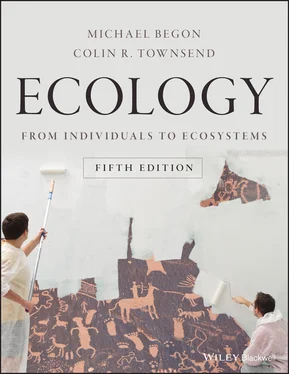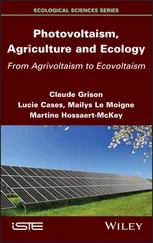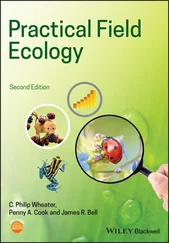elasticity analysis and thistle control
Elasticity analysis has been applied, too, to populations of the nodding thistle ( Carduus nutans) , a noxious weed that is prickly and unpalatable to most livestock, and that has expanded from its Eurasian origins to invade many parts of the world, including Australia and New Zealand. The question at issue in this case is why control measures for the thistle that are effective in one part of the world are not always effective elsewhere. The life cycle graph for the thistle has the same structure in the two countries ( Figure 4.19), comprising four stages: a seed bank, and small, medium and large plants. In fact, ‘size’ is defined not literally but on the basis of their probability of flowering: <20%, 20–80%, and >80%, respectively, since the size–flowering relationship itself varies between the countries. Field data from sites in each country, summarised in the projection matrices in Figure 4.20, indicate that the detailed demography was also rather different in the two cases. In Australia, fecundity was relatively low compared with New Zealand, as indicated by transitions in the matrix from small, medium and large plants either into the seed bank, or directly into small plants, following germination (highlighted in bold in the matrices). Germination from the seed bank to small plants in Australia was also relatively low. On the other hand, the probabilities of surviving within a size‐class and of surviving and growing into the next size‐class were noticeably higher in Australia. This translates into values of R = 1.2 for the high survival, low fecundity Australian population, and R = 2.2 for the high fecundity, low survival New Zealand population, although despite this difference, the species is a highly invasive weed in both countries.
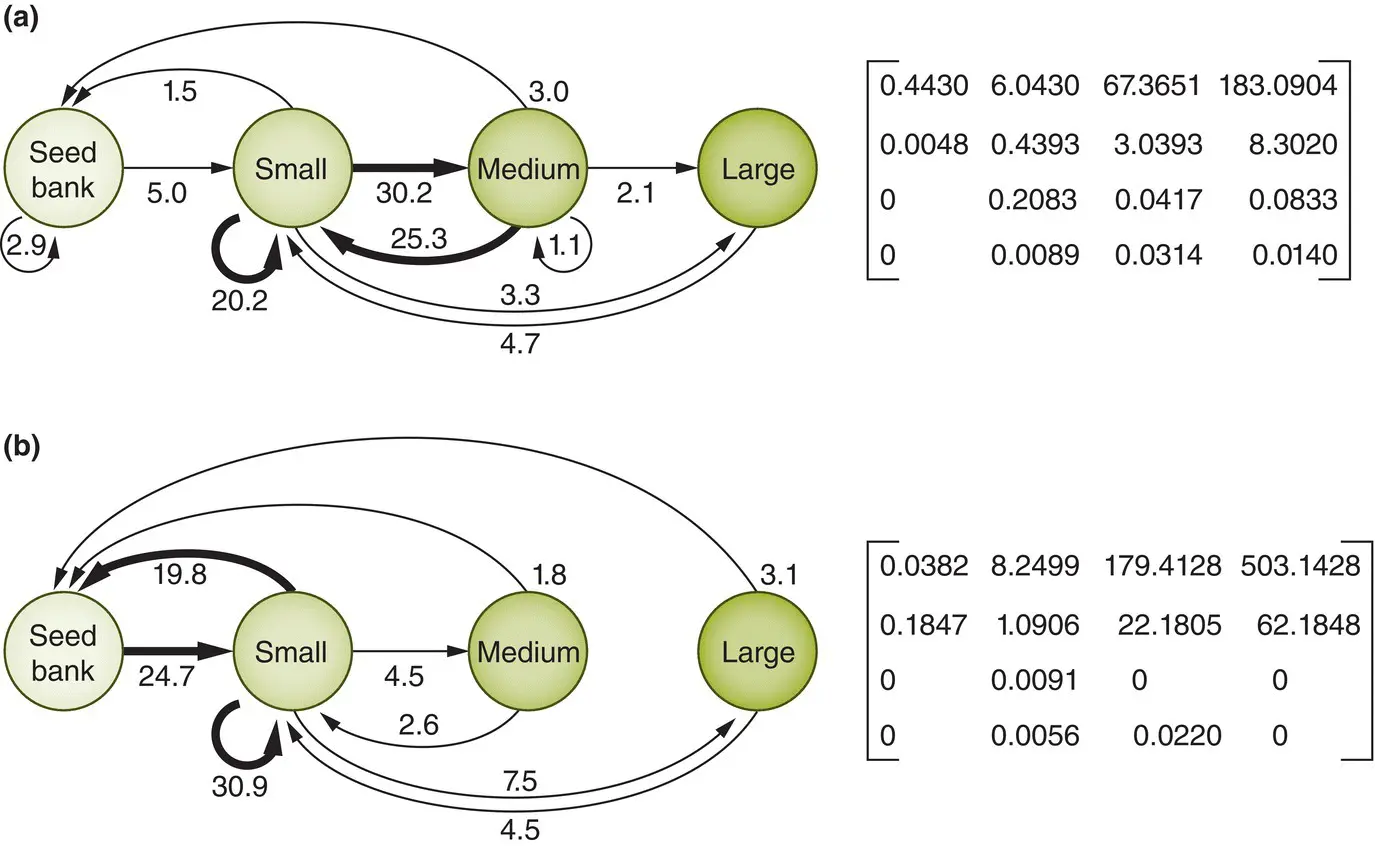
Figure 4.20 Elasticity analysis can guide the management of thistle abundance.(a) Life cycle graph and population projection matrix for the nodding thistle, Carduus nutans , in Australia, comprising a seed bank and small, medium and large plants. (b) The equivalent for a population in New Zealand. The arrows in the life cycle graphs are the transitions from year to year (survival, fecundity, growth and (for the seed bank) dormancy) and the numbers associated with them are the elasticities of R to these transitions, expressed as percentages of total elasticity. Dominant elasticities (≥20%) are indicated with bold arrows.
Source : After Shea et al . (2005).
These differences in demography led in turn to differences in the elasticities in the two cases ( Figure 4.20). For the Australian population, the dominant transitions were the cycle from small and medium plants back to small plants via seed production and germination, the survival of small plants (hence two contributions to the bold arrow in Figure 4.20a from small back to small plants), and the growth of small into medium plants. For the New Zealand population, the dominant transitions again included the production of small plants by small plants via germinated seed, but also the addition of seeds to the seed bank by small plants and the germination of those seeds.
The vulnerabilities of the two populations to control measures are therefore also different. The main options are three species of insect: two beetles and a fly (biological control of pests and weeds is discussed fully in Chapter 15). First, the thistle receptacle weevil, Rhinocyllus conicus , reduces seed set of thistles by around 30–35% in both Australia and New Zealand. Its release has been the most effective measure in controlling thistles in many parts of the world, but not, seemingly, in New Zealand. Second, the receptacle gallfly, Urophora solstitialis , reduces seed production by around 70% in Australia, though no estimates are available for New Zealand. And last, the root‐crown weevil, Trichosirocalus horridus , reduces plant growth by around 87% and thus affects both survival and fecundity. It is this species that has seemed to be most effective in Australia, and the elasticity analysis is entirely consistent with this, since growth and survivorship are relatively important there, compared with reproduction.
In New Zealand, by contrast, targeting seed production would seem from the elasticity analysis to be the most appropriate strategy, and the lack of success of R. conicus there is therefore likely to be a result not of inappropriate targeting but of the ineffectiveness of R. conicus (Shea & Kelly, 1998). This in turn suggests that the subsequent release of the gallfly should have been more successful, but sadly this seems not to have been the case either, perhaps because young gallfly larvae are themselves preyed upon by R. conicus larvae (Groenteman et al ., 2011). As these authors remark, ‘Thirty‐five years into the biocontrol programme and three agents later, C. nutans is still a major weed in parts of New Zealand’. Elasticity analyses of population projection matrices can direct managers to a pest’s vulnerabilities, but they cannot conjure up effective biocontrol agents.
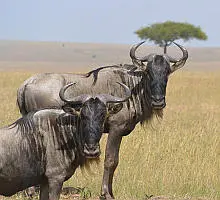
Chapter 5 Intraspecific Competition
5.1 Introduction
Organisms grow, reproduce and die ( Chapter 4). They are affected by the conditions in which they live ( Chapter 2) and by the resources that they obtain ( Chapter 3). But no organism lives alone. Each, for at least part of its life, is part of a population of its own species.
a definition of competition
Competition can be defined as an interaction between individuals brought about by a shared requirement for a resource, leading to a reduction in the survivorship, growth and/or reproduction of at least some of the individuals concerned. Individuals of the same species have very similar requirements for survival, growth and reproduction, but their combined demand for a resource may exceed the immediate supply. The individuals then compete for the resource and at least some of them will become deprived. In this chapter we examine the nature of such intraspecific competition, its effects on the competing individuals and on populations of competing individuals.
Consider, initially, a simple hypothetical community: a thriving population of grasshoppers (all of one species) feeding on a field of grass (also of one species). To provide themselves with energy and material for growth and reproduction, grasshoppers must find and eat grass, but use energy in doing so. A grasshopper that finds itself at a spot where there is no grass because another grasshopper has eaten it must move on and expend more energy before it takes in food. The more grasshoppers there are, the more this will happen, increasing energy expenditure, decreasing the rate of food intake, and hence potentially decreasing its chances of survival and leaving it less energy for development and reproduction. Survival and reproduction determine a grasshopper’s contribution to the next generation. Hence, the more intraspecific competitors for food a grasshopper experiences, the less its likely contribution will be.
As far as the grass itself is concerned, an isolated seedling in fertile soil may have a very high chance of surviving to reproductive maturity. It will probably exhibit extensive modular growth and probably, therefore, eventually produce many seeds. However, a seedling that is closely surrounded by neighbours (shading it with their leaves and depleting the water and nutrients of its soil with their roots) will be very unlikely to survive, and if it does, will almost certainly form few modules and set few seeds.
Читать дальше
